Multi-Physical Field Coupling Simulation and Experimental Study on the Radiation Characteristics of Sawing Noise from Circular Saw Blades in Woodworking
Abstract
1. Introduction
2. Multi-Physical Field Coupling Model for Sawing System
2.1. Thermo-Mechanical Coupling Model
2.2. Acoustic–Structural Coupling Model
3. Multi-Physical Field Coupling Model Solving
3.1. Materials
3.2. Multi-Physical Field Coupling Simulation Process
3.2.1. Thermal Conduction Simulation
3.2.2. Pre-Stress Modal Simulation
3.2.3. Vibration Response Simulation
3.2.4. Sound Field Radiation Simulation
4. Design of Experiments
4.1. Modal Test
4.2. Noise Test
5. Results and Discussion
5.1. Modal and Vibration Response Analysis
5.2. Noise Frequency Domain Response Analysis
5.3. Noise Spatial Distribution Analysis
5.3.1. Spatial Sound Field Attenuation Analysis
5.3.2. Noise Directionality Analysis
5.4. Noise Reduction Design Method Based on Noise Radiation Characteristics
6. Conclusions
- The multi-physics field coupling simulation model, based on theoretical analysis of sawing vibration noise, demonstrates high consistency with experimental data, validating its accuracy in predicting the frequency-domain characteristics and spatial distribution of sawing noise.
- Sawing noise shows clear frequency dependence. In the low-frequency band (f < 500 Hz), the acoustic field is uniformly distributed with low radiation efficiency, primarily affecting the dynamic stability of the circular saw blade. In the mid-frequency band (500 Hz–8000 Hz), the cyclic vibration of the saw teeth in contact with the material significantly increases, leading to a rapid rise in sound pressure levels. Higher-order modal vibrations excite a more complex acoustic field distribution, which is the primary source of noise. In the high-frequency band (8000 Hz–20 kHz), sound pressure levels attenuate significantly due to reduced vibration excitation, increased medium absorption, and other factors, resulting in low radiation efficiency.
- The simulation results show distinct vibration noise directivity at different excitation frequencies. The direction parallel to the saw blade (0° and 180° measurement points) exhibits lower sound pressure levels, while other directions show higher but more consistent levels. Overall, the distribution is symmetrical in the X and Y directions. However, experimental measurements reveal multi-source superposition of processing noise with less distinct directivity.
- In-depth analysis of sawing noise radiation characteristics provides theoretical guidance for the design of noise reduction strategies for circular saw blades. The incorporation of noise reduction slots effectively suppresses noise in the mid-frequency range, while sound barrier structures significantly reduce the propagation of high-frequency noise.
Author Contributions
Funding
Data Availability Statement
Conflicts of Interest
References
- Kvietková, M.; Gaff, M.; Gašparík, M.; Kminiak, R.; Kriš, A. Effect of number of saw blade teeth on noise level and wear of blade edges during cutting of wood. BioResources 2015, 10, 1657–1666. [Google Scholar] [CrossRef]
- Kang, J.; Zhang, H.; Zhang, J.; Yuan, X.; Lv, C.; Bai, T.; Gong, Y.; Guo, J. Development of a novel circular saw blade substrate with high stiffness for mitigating vibration noise and improving sawing performance. Mech. Syst. Signal Process. 2025, 223, 111934. [Google Scholar] [CrossRef]
- Stevenson, D.; Gray, W.; Hoong, K.; Speller, M. Quietening circular saws by reducing blade vibration. Noise Control. Eng. J. 1989, 33, 33–36. [Google Scholar] [CrossRef]
- Svoren, J.; Javorek, L.; Murin, L. Effect of the shape of compensating slots in the body of a circular saw blade on noise level in the cutting process. Pro Ligno 2010, 6, 5–12. [Google Scholar]
- Droba, A.; Javorek, L.; Svoren, J.; Paulíny, D. New design of circular saw blade body and its influence on critical rotational speed. Drew. Pr. Nauk. Doniesienia Komun. 2015, 58, 147–157. [Google Scholar] [CrossRef]
- Svoreň, J.; Naščák, L.; Koleda, P.; Barcík, Š.; Němec, M. The circular saw blade body modification by elastic material layer effecting circular saws sound pressure level when idling and cutting. Appl. Acoust. 2021, 179, 108028. [Google Scholar] [CrossRef]
- Chang, W.T.; Chen, L.C. Design and experimental evaluation of a circular saw blade with self-clamped cutting inserts. Int. J. Adv. Manuf. Technol. 2016, 83, 365–379. [Google Scholar] [CrossRef]
- Takeyama, K.; Yokochi, H.; Nishio, S.; Tsuchikawa, S. Characteristics of Resonance Sound in a Circular Saw Enclosure. BioResources 2023, 18. [Google Scholar] [CrossRef]
- Szymani, R.; Mote, C. Principal developments in thin circular saw vibration and control research: Part 2: Reduction and control of saw vibration. Holz Als-Roh-Und Werkst. 1977, 35, 219–225. [Google Scholar] [CrossRef]
- Wang, C.Y.; Hu, Y.N.; Wang, Z.; Ding, H. Noise and vibration of diamond sawblade for concrete dry cutting. Key Eng. Mater. 2005, 291, 103–108. [Google Scholar] [CrossRef]
- Martin, B.; Bies, D. On aerodynamic noise generation from vortex shedding in rotating blades. J. Sound Vib. 1992, 155, 317–324. [Google Scholar] [CrossRef]
- Leu, M.; Mote, C. Origin of idling noise in circular saws and its suppression. Wood Sci. Technol. 1984, 18, 33–49. [Google Scholar] [CrossRef]
- Citarella, R.; Federico, L.; Cicatiello, A. Modal acoustic transfer vector approach in a FEM–BEM vibro-acoustic analysis. Eng. Anal. Bound. Elem. 2007, 31, 248–258. [Google Scholar] [CrossRef]
- Chen, L.; Lian, H.; Pei, Q.; Meng, Z.; Jiang, S.; Dong, H.W.; Yu, P. FEM-BEM analysis of acoustic interaction with submerged thin-shell structures under seabed reflection conditions. Ocean. Eng. 2024, 309, 118554. [Google Scholar] [CrossRef]
- Minciunescu, P.; Marinescu, S.; Hănţilă, F.; Drosu, O.M. FEM-BEM technique for solving the magnetic field in electric machines. Rev. Roum. Sci. Techn. Électrotechn. et Énerg 2011, 56, 189–198. [Google Scholar]
- Maeder, M.; D’Auria, R.; Grasso, E.; Petrone, G.; De Rosa, S.; Klaerner, M.; Kroll, L.; Marburg, S. Numerical analysis of sound radiation from rotating discs. J. Sound Vib. 2020, 468, 115085. [Google Scholar] [CrossRef]
- Yao, T.; Duan, G.; Wang, T. Coupled FEM/BEM Method for Noise Prediction of Common and Sandwich Circular Saw Blades. Key Eng. Mater. 2016, 693, 463–470. [Google Scholar] [CrossRef]
- Tian, Y.; Duan, G.; Xia, X.; Zhang, E. Optimization Design of Low Noise Circular Saw Parameters Combining Response Surface Model with Hybrid Optimization Algorithm. China Mech. Eng. 2016, 27, 3025. [Google Scholar]
- Li, Z.; Yu, H.; Bai, Y. Numerical simulation of CO2-ECBM based on multi-physical field coupling model. Sustainability 2022, 14, 11789. [Google Scholar] [CrossRef]
- Wang, Q.; Zhang, X.; Wang, D.; Cui, H.; Zhang, S.; Wang, J. Numerical simulation and experimental investigation on the thermal-fluid-solid multi-physical field coupling characteristics of wet friction pairs considering cavitation effect. Appl. Therm. Eng. 2025, 260, 124955. [Google Scholar] [CrossRef]
- Wang, Y.; Xu, Z.; Meng, D.; Liu, L.; Fang, Z. Multi-Physical Field Coupling Simulation and Experiments with Pulse Electrochemical Machining of Large Size TiAl Intermetallic Blade. Metals 2023, 13, 985. [Google Scholar] [CrossRef]
- Tian, Y.; Duan, G.; Xia, X.; Zhang, E. Calculations and Analyseis on Aerodynamic Noise Characteristics of Rotating Saw Blades. China Mech. Eng. 2017, 28, 272. [Google Scholar]
- Kang, J.; Zhang, H.; Zhang, J.; Wang, K.; Bai, T. Dynamic response of circular saw blade based on dynamic sawing force model in machining hard aluminum alloys. Measurement 2024, 231, 114616. [Google Scholar] [CrossRef]
- Li, S.; Wang, C.; Zheng, L.; Wang, Y.; Xu, X.; Ding, F. Dynamic stability of cemented carbide circular saw blades for woodcutting. J. Mater. Process. Technol. 2016, 238, 108–123. [Google Scholar] [CrossRef]
- Mote Jr, C. Stability of circular plates subjected to moving loads. J. Frankl. Inst. 1970, 290, 329–344. [Google Scholar] [CrossRef]
- Wang, Z.; Wu, S.F. Helmholtz equation–least-squares method for reconstructing the acoustic pressure field. J. Acoust. Soc. Am. 1997, 102, 2020–2032. [Google Scholar] [CrossRef]
- Peng, T.; Hou, F.; Zou, X.; Qi, Z.; Han, X. Acoustic insulation performance of laminated plates based on equivalent FE-BEM method. J. Aerosp. Power 2024, 39, 14–21. [Google Scholar]
- Jia, N.; Guo, L.; Wang, R.; Liu, J. Design of vibration and noise reduction for ultra-thin cemented carbide circular saw blades in woodworking based on multi-objective optimization. Forests 2024, 15, 1554. [Google Scholar] [CrossRef]
- Ding, Y.; Ma, Y.; Liu, T.; Zhang, J.; Yang, C. Experimental Study on the Dynamic Stability of Circular Saw Blades during the Processing of Bamboo-Based Fiber Composite Panels. Forests 2023, 14, 1855. [Google Scholar] [CrossRef]
- Czajkowski, Ł.; Olek, W.; Weres, J.; Guzenda, R. Thermal properties of wood-based panels: Specific heat determination. Wood Sci. Technol. 2016, 50, 537–545. [Google Scholar] [CrossRef]
- Svoreň, J.; Javorek, L.; Krajčovičová, M.; Klobušiaková, K.; Kubovskỳ, I.; Kminiak, R. The effect of the circular saw blade body structure on the concentric distribution of the temperature along the radius during the wood cutting process. Wood Res. 2017, 62, 427–436. [Google Scholar]
- Rieß, S.; Kaal, W.; Herold, S. Vibration reduction on circular saw blades with vibroacoustic metamaterials. Bull. Pol. Acad. Sci. Tech. Sci. 2023, 71. [Google Scholar] [CrossRef]
- Yu, J.; Zhang, J.; Wang, Z.; Ye, L.; Ge, J.; Gao, L. Study on the hole shape of diamond circular saw blades with noise reduction holes based on FEM/BEM. Diam. Abrasives Eng. 2016, 36, 63–67+74. [Google Scholar]
- Pastor, M.; Binda, M.; Harčarik, T. Modal assurance criterion. Procedia Eng. 2012, 48, 543–548. [Google Scholar] [CrossRef]
- Krilek, J.; Kováč, J.; Barcík, Š.; Svoreň, J.; Štefánek, M.; Kuvik, T. The influence of chosen factors of a circular saw blade on the noise level in the process of cross cutting wood. Wood Res. 2016, 61, 475–486. [Google Scholar]
- Fotsch, D.; Ewins, D. Application of MAC in the Frequency Domain. Rolls Royce PLC-Report-PNR. 2000. Available online: https://citeseerx.ist.psu.edu/document?repid=rep1&type=pdf&doi=93c56831cfee2f33937b8a1202069f503c516a09 (accessed on 22 January 2025).
- Wu, S.F. Methods for reconstructing acoustic quantities based on acoustic pressure measurements. J. Acoust. Soc. Am. 2008, 124, 2680–2697. [Google Scholar] [CrossRef]
- Ma, J.; Lü, J.; Huang, X.; Chen, T. Estimation of sound power of noise from large cold saw machines. J. Appl. Mech. 2001, 3, 28–32+148. [Google Scholar]
- Attenborough, K. Sound propagation in the atmosphere. Springer Handbook of Acoustics; Springer: Berlin/Heidelberg, Germany, 2014; pp. 117–155. [Google Scholar]
- Chatillon, J. Influence of source directivity on noise levels in industrial halls: Simulation and experiments. Appl. Acoust. 2007, 68, 682–698. [Google Scholar] [CrossRef]
- Cho, H.; Mote, C., Jr. On the aerodynamic noise source in circular saws. J. Acoust. Soc. Am. 1979, 65, 662–671. [Google Scholar] [CrossRef]
- Stewart, J.S. An investigation of the aerodynamic noise generation mechanism of circular saw blades. Noise Control. Eng. 1978, 11, 5–11. [Google Scholar] [CrossRef]
- Reiter, W., Jr.; Keltie, R. On the nature of idling noise of circular saw blades. J. Sound Vib. 1976, 44, 531–543. [Google Scholar] [CrossRef]
- Pohl, M.; Rose, M. Piezoelectric shunt damping of a circular saw blade with autonomous power supply for noise and vibration reduction. J. Sound Vib. 2016, 361, 20–31. [Google Scholar] [CrossRef]
- Zhao, W.; Chen, L.; Zheng, C.; Liu, C.; Chen, H. Design of absorbing material distribution for sound barrier using topology optimization. Struct. Multidiscip. Optim. 2017, 56, 315–329. [Google Scholar] [CrossRef]
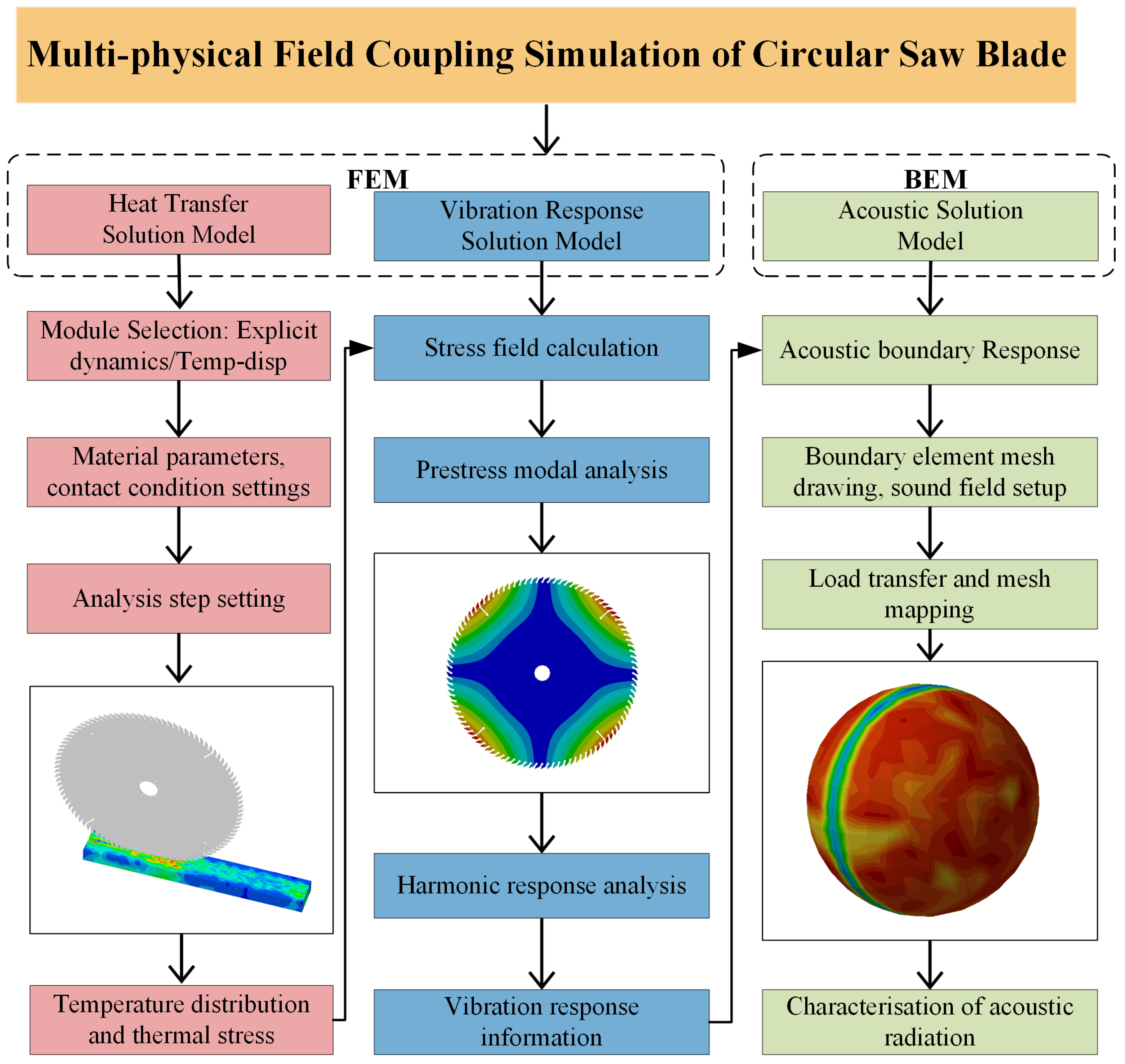
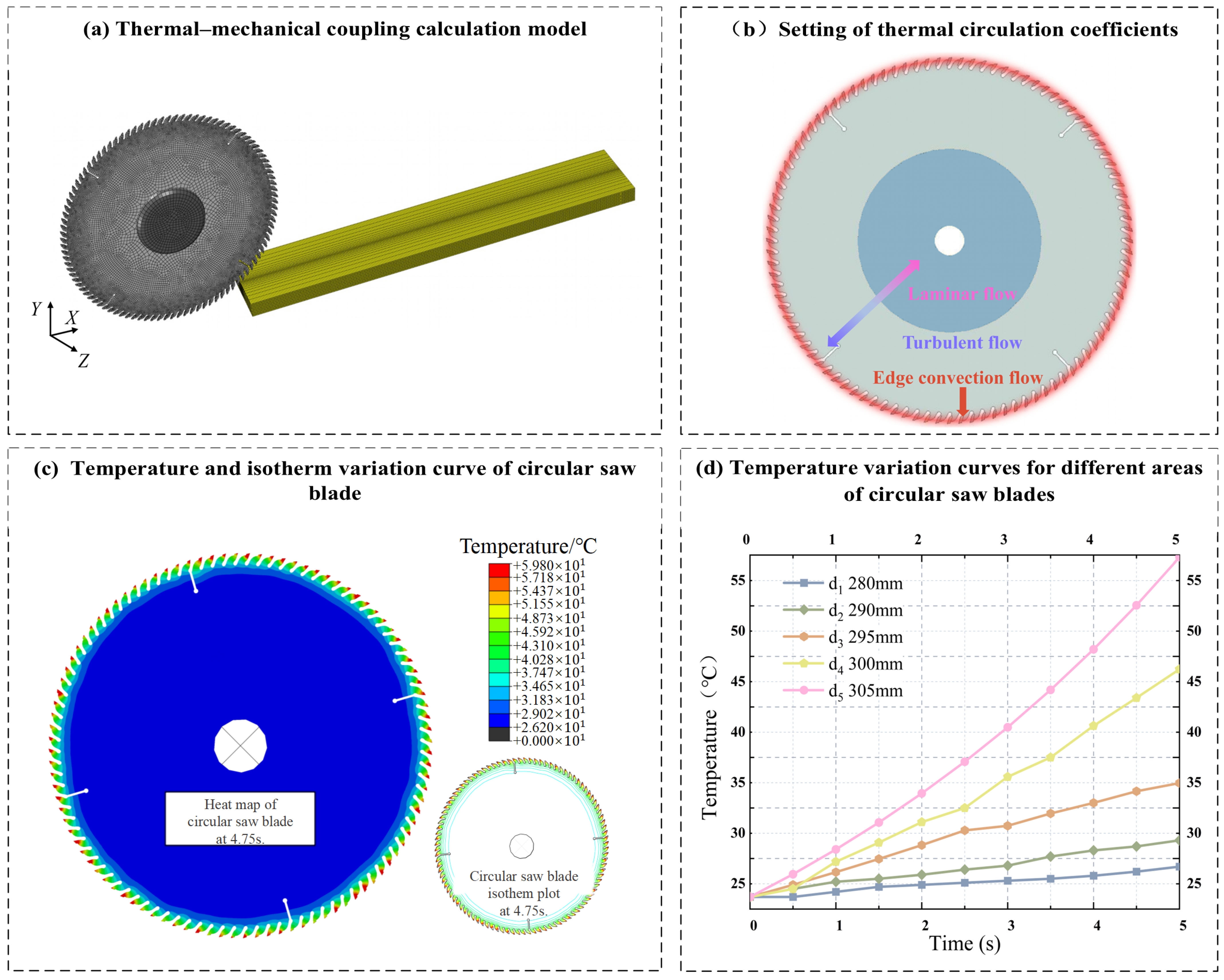
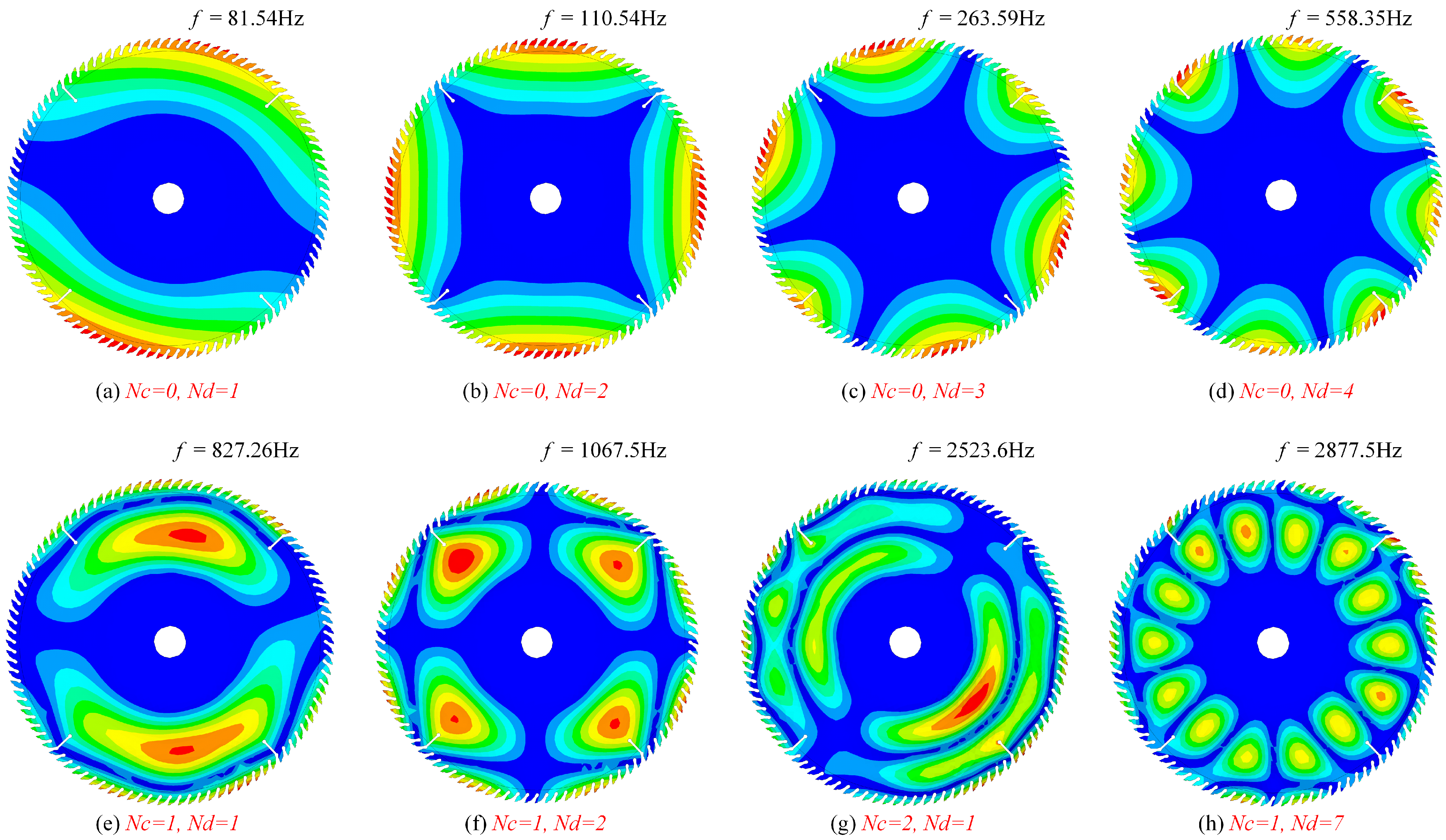
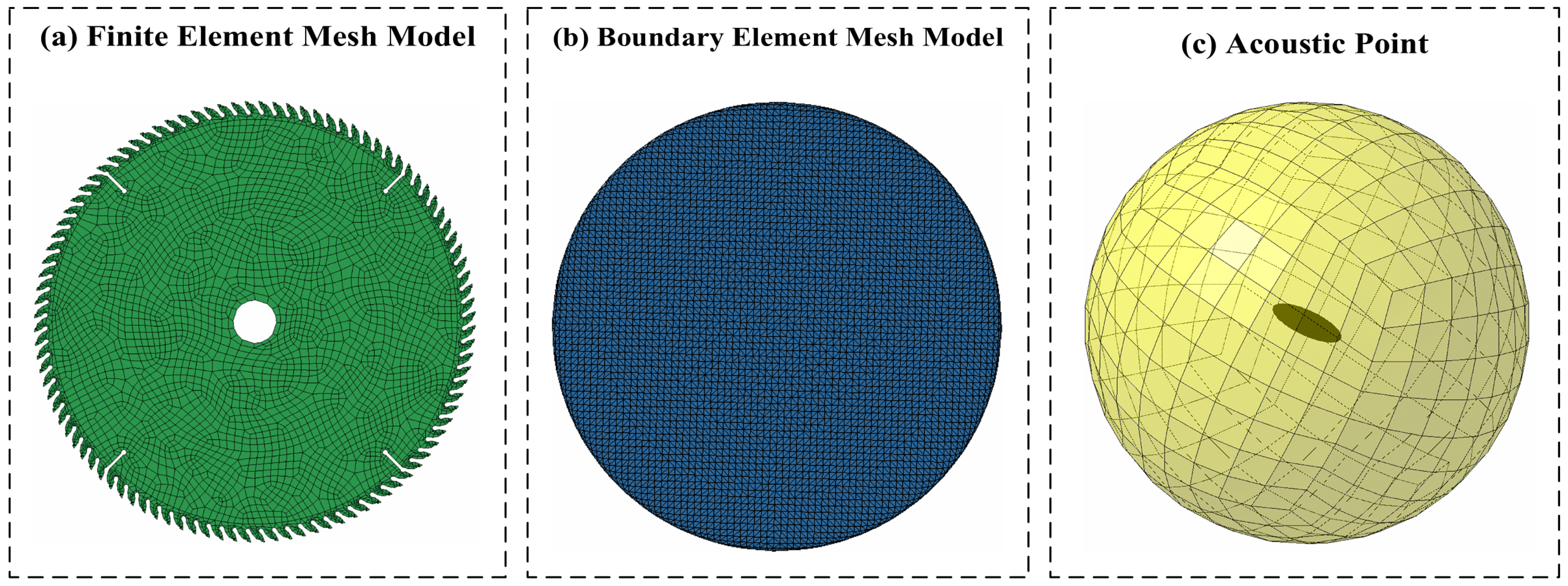
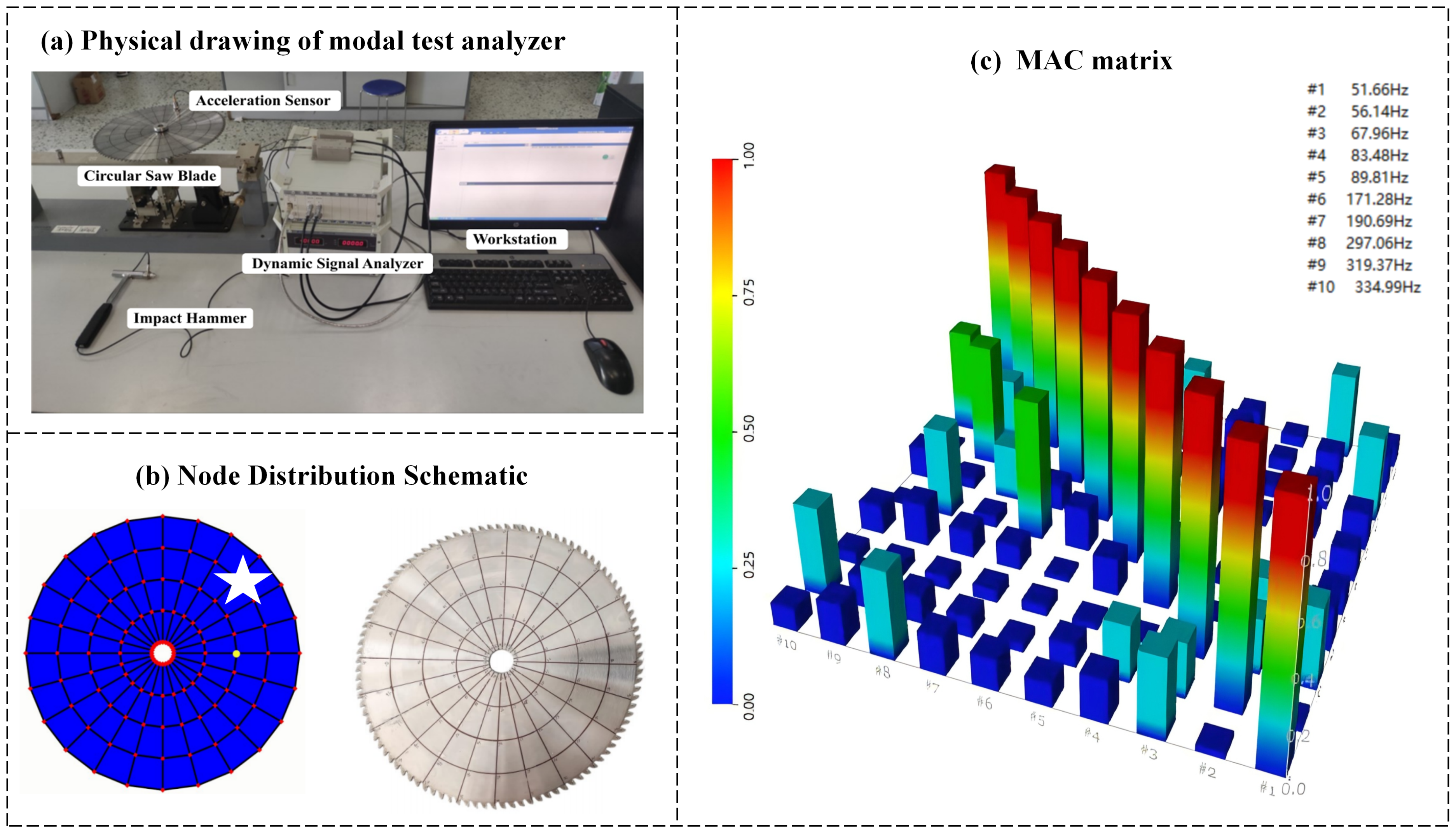

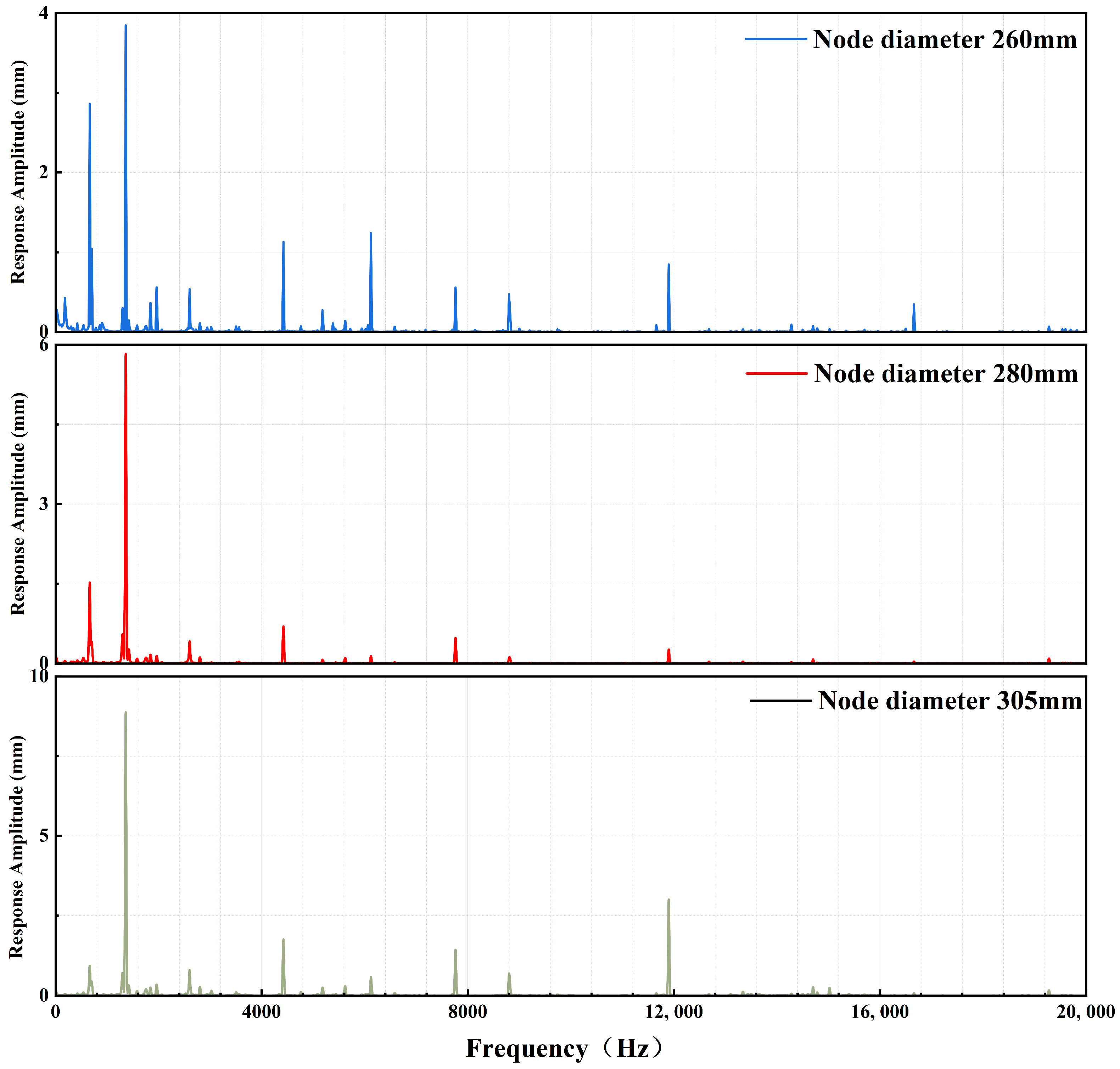
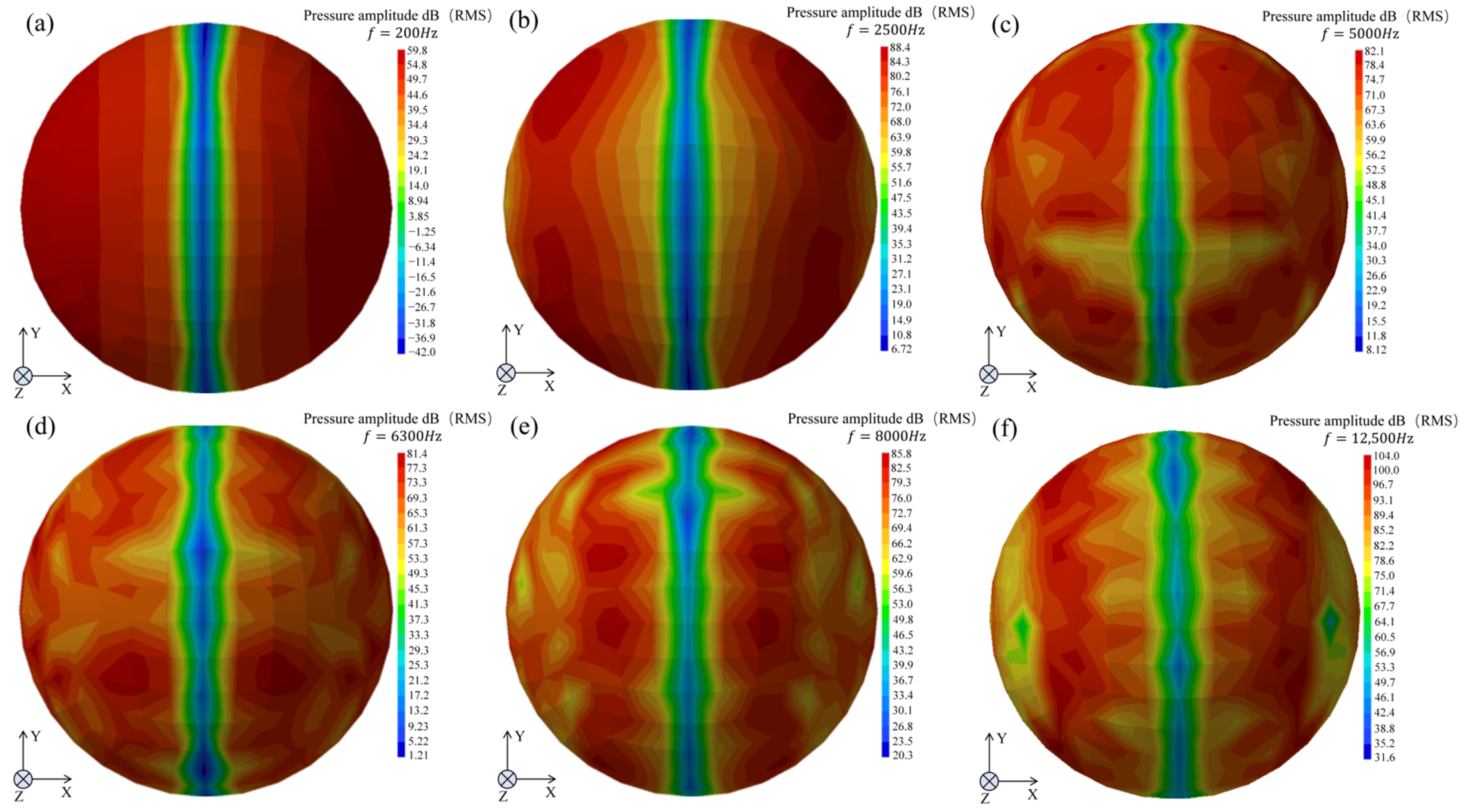
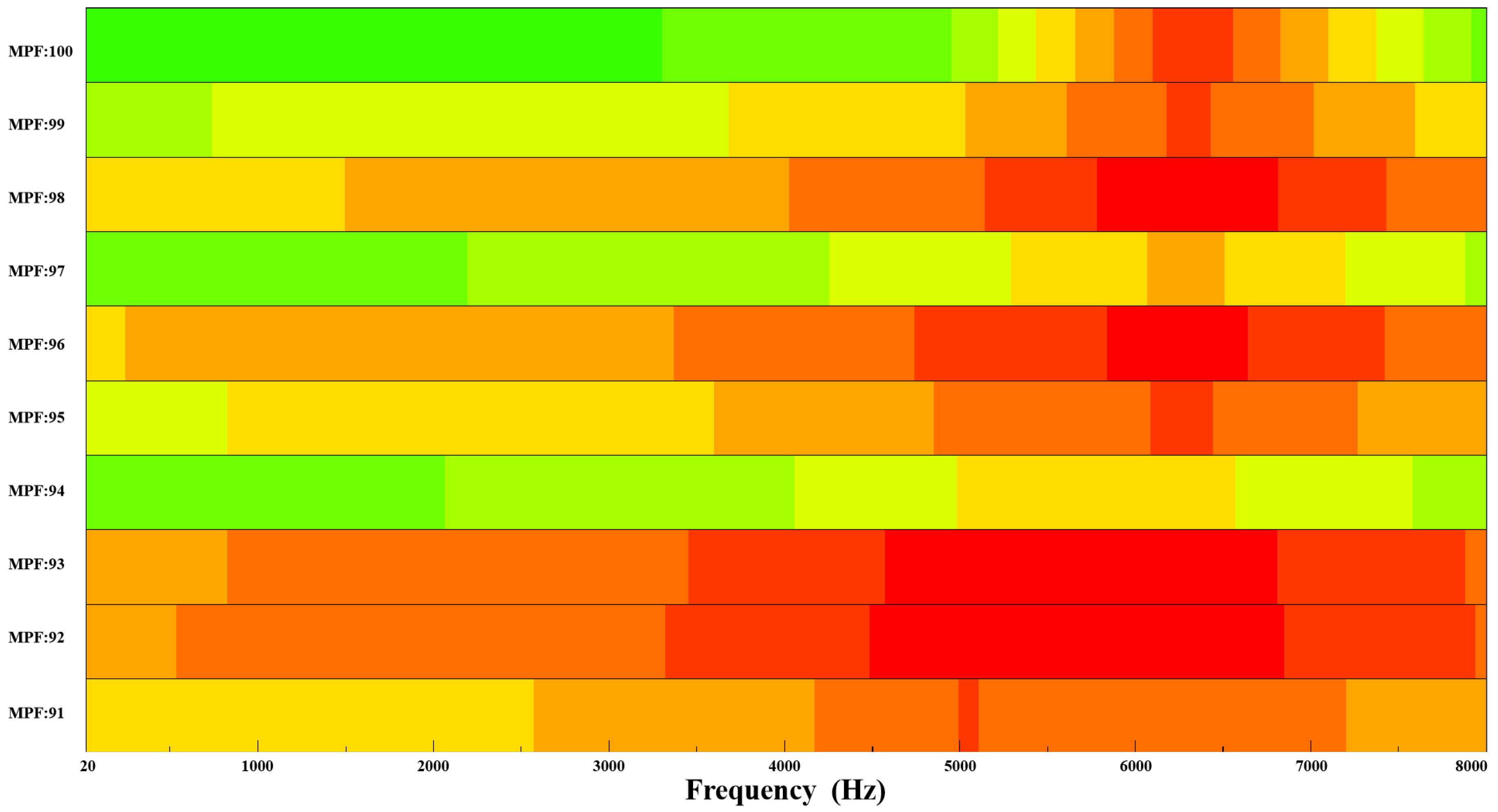


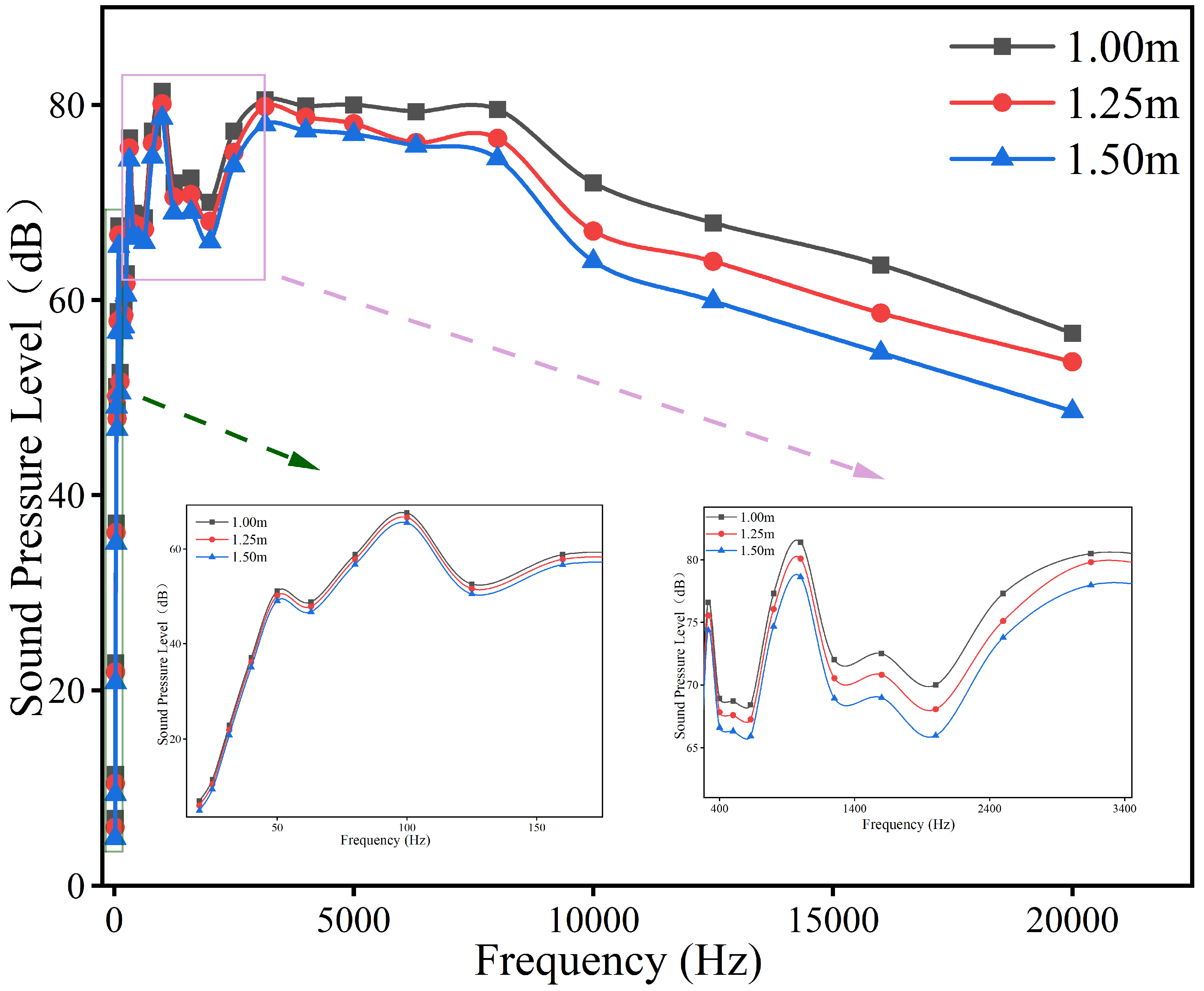
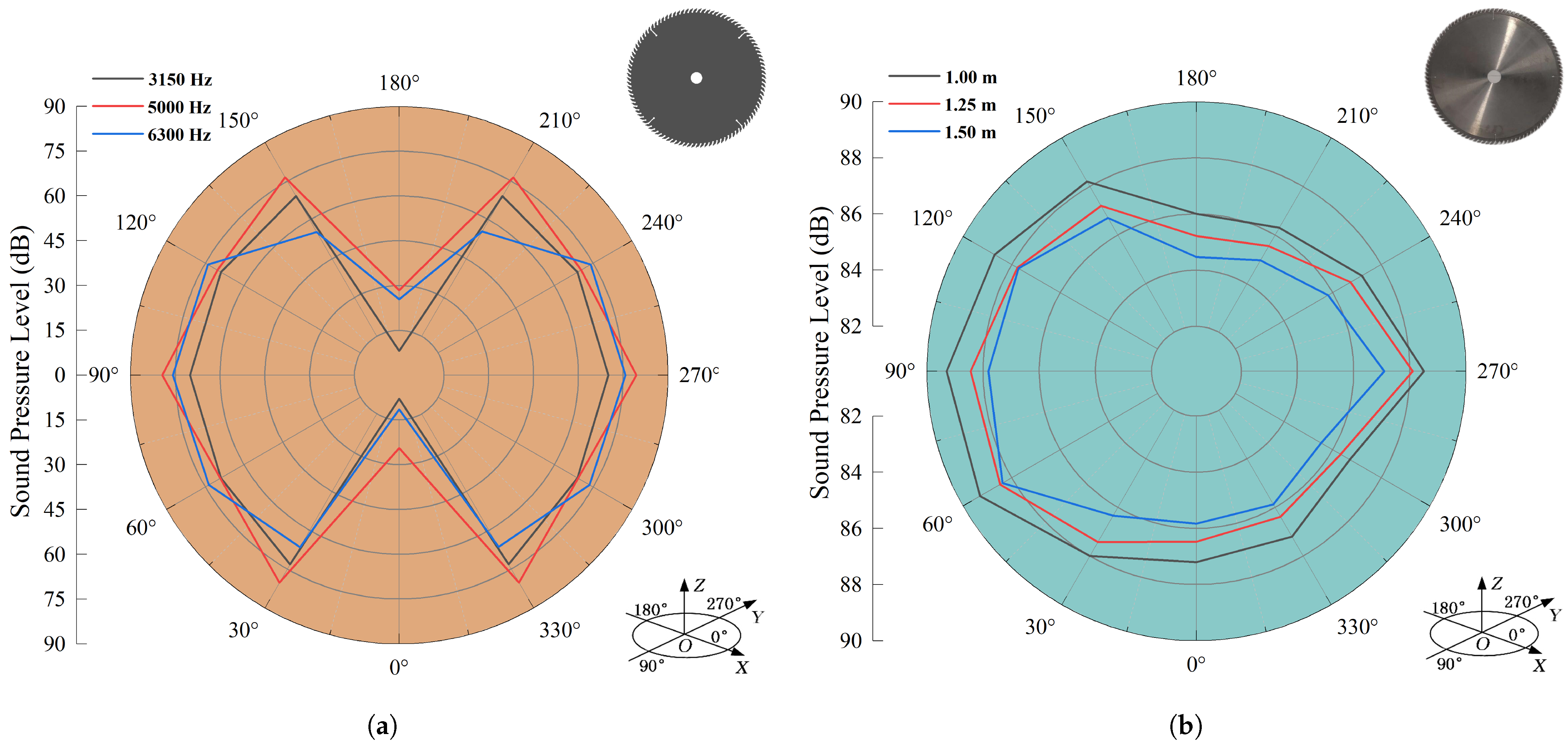
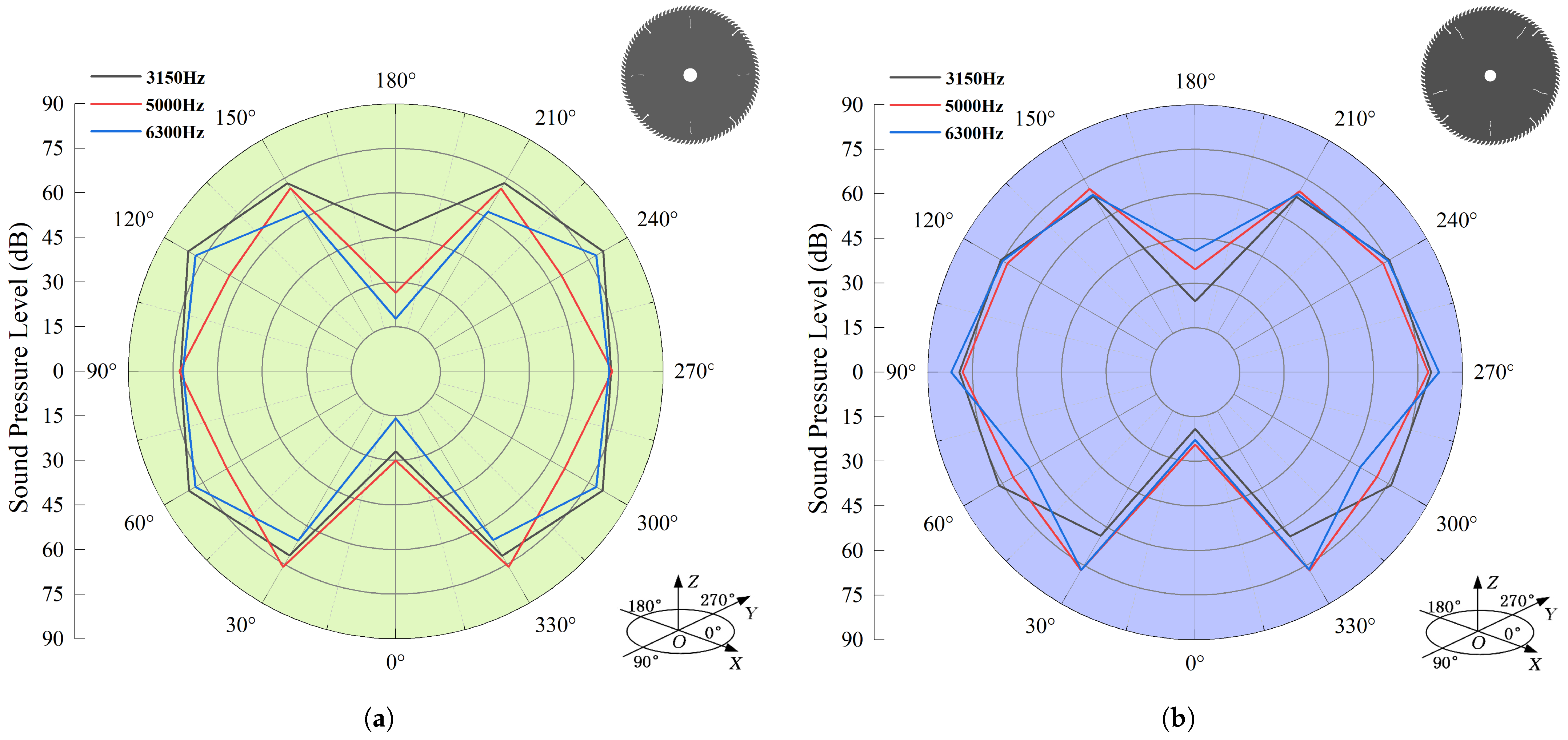
| Materials | SKS51 (Saw Body) | YG6 (Serrated) |
|---|---|---|
| Density (kg/m3) | 7850 | 14,800 |
| Poisson’s ratio | 0.28 | 0.30 |
| Modulus of elasticity (GPa) | 210 | 510 |
| Coefficient of thermal expansion (1/K) | ||
| Specific heat (J/kg·°C) | 460 | 220 |
| Thermal conductivity (W/mK) | 51.9 | 75.0 |
| Property | Density (g/cm3) | Poisson’s Ratio | Modulus of Elasticity (MPa) | Bending Strength (MPa) | Coefficient of Thermal Expansion (1/K) | Specific Heat (J/kg·°C) | Thermal Conductivity (W/mK) |
|---|---|---|---|---|---|---|---|
| Chipboard | 0.65 | 0.342 | 504 | 79 | 3841 | 0.165 |
| Order | Test Value/Hz | Simulation Value/Hz | Inaccuracy/% | Order | Test Value/Hz | Simulation Value/Hz | Inaccuracy/% |
|---|---|---|---|---|---|---|---|
| 1 | 51.66 | 51.45 | 0.41 | 6 | 171.28 | 183.23 | 6.52 |
| 2 | 56.14 | 51.59 | 8.82 | 7 | 190.69 | 183.24 | 4.07 |
| 3 | 67.96 | 62.55 | 8.65 | 8 | 297.06 | 316.48 | 6.14 |
| 4 | 83.48 | 83.35 | 1.56 | 9 | 319.37 | 319.77 | 0.13 |
| 5 | 89.81 | 83.61 | 7.42 | 10 | 334.99 | 362.77 | 7.66 |
| Environmental Noise (dB) | Idling Noise (dB) | Sawing Noise (dB) | Net Sawing Noise (dB) | |
|---|---|---|---|---|
| 20 Hz | 4.7 | 4.8 | 6.9 | 2.74 |
| 25 Hz | 8.1 | 8.5 | 11.4 | 8.28 |
| 31.5 Hz | 21.8 | 22.6 | 22.8 | 9.33 |
| 40 Hz | 34.5 | 34.8 | 37.1 | 33.24 |
| 50 Hz | 50.8 | 50.9 | 51.1 | 37.63 |
| 63 Hz | 45.8 | 47.0 | 48.8 | 44.11 |
| 80 Hz | 54.6 | 56.1 | 58.8 | 55.46 |
| 100 Hz | 62.4 | 66.5 | 67.6 | 61.10 |
| 125 Hz | 52.1 | 52.4 | 52.6 | 39.13 |
| 160 Hz | 58.1 | 58.4 | 58.8 | 48.24 |
| 200 Hz | 58.5 | 59.0 | 59.4 | 48.84 |
| 250 Hz | 59.4 | 61.6 | 62.7 | 56.20 |
| 315 Hz | 69.3 | 76.5 | 76.6 | 60.17 |
| 400 Hz | 67.7 | 68.4 | 68.9 | 59.26 |
| 500 Hz | 66.0 | 66.9 | 68.7 | 64.01 |
| 630 Hz | 65.8 | 66.4 | 68.4 | 64.07 |
| 800 Hz | 64.8 | 64.9 | 77.3 | 77.04 |
| 1000 Hz | 62.7 | 63.0 | 81.4 | 81.34 |
| 1250 Hz | 62.9 | 62.9 | 72.0 | 71.43 |
| 1600 Hz | 62.9 | 62.9 | 72.5 | 72.00 |
| 2000 Hz | 60.2 | 61.2 | 70.0 | 69.39 |
| 2500 Hz | 61.1 | 64.1 | 77.3 | 77.09 |
| 3150 Hz | 60.6 | 67.0 | 80.5 | 80.30 |
| 4000 Hz | 57.1 | 68.8 | 79.9 | 79.55 |
| 5000 Hz | 51.9 | 71.4 | 80.0 | 79.35 |
| 6300 Hz | 50.1 | 66.4 | 79.3 | 79.07 |
| 8000 Hz | 48.0 | 60.9 | 79.5 | 79.44 |
| 10,000 Hz | 40.1 | 57.4 | 72.0 | 71.85 |
| 12,500 Hz | 33.6 | 52.8 | 67.9 | 67.76 |
| 16,000 Hz | 30.4 | 48.1 | 63.6 | 63.48 |
| 20,000 Hz | 26.8 | 42.6 | 56.6 | 56.42 |
| LAmax | 78.5 | 81.0 | 92.0 | |
| LAmin | 75.3 | 79.6 | 87.2 | |
| LAeq,T | 76.6 | 80.2 | 89.3 |
Disclaimer/Publisher’s Note: The statements, opinions and data contained in all publications are solely those of the individual author(s) and contributor(s) and not of MDPI and/or the editor(s). MDPI and/or the editor(s) disclaim responsibility for any injury to people or property resulting from any ideas, methods, instructions or products referred to in the content. |
© 2025 by the authors. Licensee MDPI, Basel, Switzerland. This article is an open access article distributed under the terms and conditions of the Creative Commons Attribution (CC BY) license (https://creativecommons.org/licenses/by/4.0/).
Share and Cite
Jia, N.; Guo, L.; Zhang, Y.; Liu, J. Multi-Physical Field Coupling Simulation and Experimental Study on the Radiation Characteristics of Sawing Noise from Circular Saw Blades in Woodworking. Forests 2025, 16, 442. https://doi.org/10.3390/f16030442
Jia N, Guo L, Zhang Y, Liu J. Multi-Physical Field Coupling Simulation and Experimental Study on the Radiation Characteristics of Sawing Noise from Circular Saw Blades in Woodworking. Forests. 2025; 16(3):442. https://doi.org/10.3390/f16030442
Chicago/Turabian StyleJia, Na, Lei Guo, Yongying Zhang, and Jiuqing Liu. 2025. "Multi-Physical Field Coupling Simulation and Experimental Study on the Radiation Characteristics of Sawing Noise from Circular Saw Blades in Woodworking" Forests 16, no. 3: 442. https://doi.org/10.3390/f16030442
APA StyleJia, N., Guo, L., Zhang, Y., & Liu, J. (2025). Multi-Physical Field Coupling Simulation and Experimental Study on the Radiation Characteristics of Sawing Noise from Circular Saw Blades in Woodworking. Forests, 16(3), 442. https://doi.org/10.3390/f16030442





